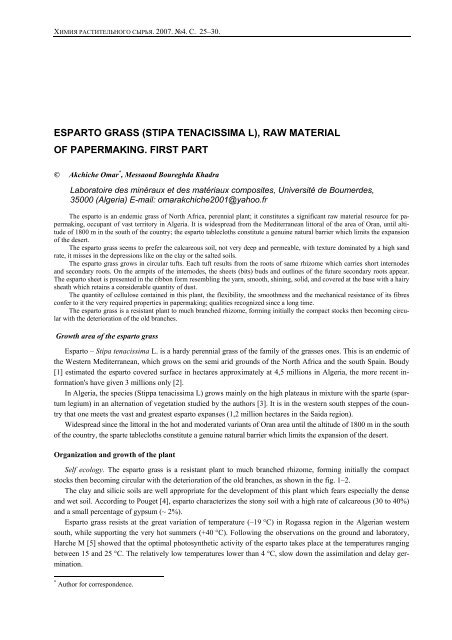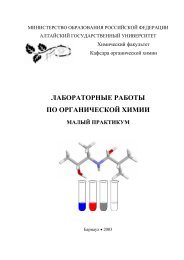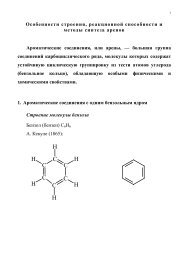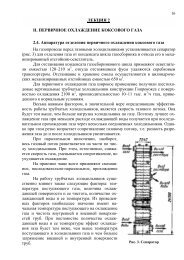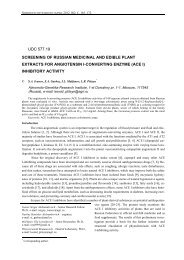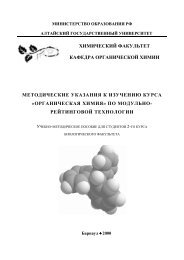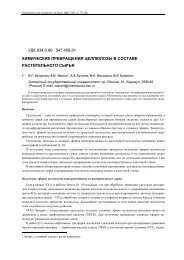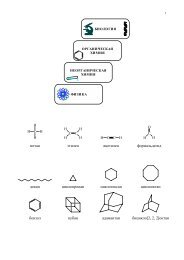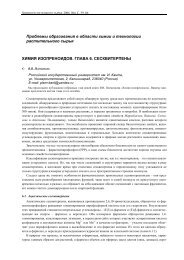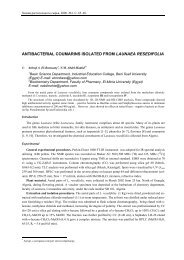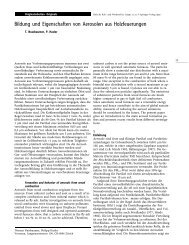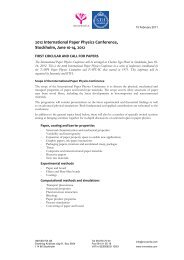ESPARTO GRASS (STIPA TENACISSIMA L), RAW MATERIAL OF ...
ESPARTO GRASS (STIPA TENACISSIMA L), RAW MATERIAL OF ...
ESPARTO GRASS (STIPA TENACISSIMA L), RAW MATERIAL OF ...
Create successful ePaper yourself
Turn your PDF publications into a flip-book with our unique Google optimized e-Paper software.
ХИМИЯ РАСТИТЕЛЬНОГО СЫРЬЯ. 2007. №4. С. 25–30.<br />
<strong>ESPARTO</strong> <strong>GRASS</strong> (<strong>STIPA</strong> <strong>TENACISSIMA</strong> L), <strong>RAW</strong> <strong>MATERIAL</strong><br />
<strong>OF</strong> PAPERMAKING. FIRST PART<br />
© Akchiche Omar * , Messaoud Boureghda Khadra<br />
Laboratoire des minéraux et des matériaux composites, Université de Boumerdes,<br />
35000 (Algeria) E-mail: omarakchiche2001@yahoo.fr<br />
The esparto is an endemic grass of North Africa, perennial plant; it constitutes a significant raw material resource for papermaking,<br />
occupant of vast territory in Algeria. It is widespread from the Mediterranean littoral of the area of Oran, until altitude<br />
of 1800 m in the south of the country; the esparto tablecloths constitute a genuine natural barrier which limits the expansion<br />
of the desert.<br />
The esparto grass seems to prefer the calcareous soil, not very deep and permeable, with texture dominated by a high sand<br />
rate, it misses in the depressions like on the clay or the salted soils.<br />
The esparto grass grows in circular tufts. Each tuft results from the roots of same rhizome which carries short internodes<br />
and secondary roots. On the armpits of the internodes, the sheets (bits) buds and outlines of the future secondary roots appear.<br />
The esparto sheet is presented in the ribbon form resembling the yarn, smooth, shining, solid, and covered at the base with a hairy<br />
sheath which retains a considerable quantity of dust.<br />
The quantity of cellulose contained in this plant, the flexibility, the smoothness and the mechanical resistance of its fibres<br />
confer to it the very required properties in papermaking; qualities recognized since a long time.<br />
The esparto grass is a resistant plant to much branched rhizome, forming initially the compact stocks then becoming circular<br />
with the deterioration of the old branches.<br />
Growth area of the esparto grass<br />
Esparto – Stipa tenacissima L. is a hardy perennial grass of the family of the grasses ones. This is an endemic of<br />
the Western Mediterranean, which grows on the semi arid grounds of the North Africa and the south Spain. Boudy<br />
[1] estimated the esparto covered surface in hectares approximately at 4,5 millions in Algeria, the more recent information's<br />
have given 3 millions only [2].<br />
In Algeria, the species (Stippa tenacissima L) grows mainly on the high plateaus in mixture with the sparte (spartum<br />
legium) in an alternation of vegetation studied by the authors [3]. It is in the western south steppes of the country<br />
that one meets the vast and greatest esparto expanses (1,2 million hectares in the Saida region).<br />
Widespread since the littoral in the hot and moderated variants of Oran area until the altitude of 1800 m in the south<br />
of the country, the sparte tablecloths constitute a genuine natural barrier which limits the expansion of the desert.<br />
Organization and growth of the plant<br />
Self ecology. The esparto grass is a resistant plant to much branched rhizome, forming initially the compact<br />
stocks then becoming circular with the deterioration of the old branches, as shown in the fig. 1–2.<br />
The clay and silicic soils are well appropriate for the development of this plant which fears especially the dense<br />
and wet soil. According to Pouget [4], esparto characterizes the stony soil with a high rate of calcareous (30 to 40%)<br />
and a small percentage of gypsum (~ 2%).<br />
Esparto grass resists at the great variation of temperature (–19 °C) in Rogassa region in the Algerian western<br />
south, while supporting the very hot summers (+40 °C). Following the observations on the ground and laboratory,<br />
Harche M [5] showed that the optimal photosynthetic activity of the esparto takes place at the temperatures ranging<br />
between 15 and 25 °C. The relatively low temperatures lower than 4 °C, slow down the assimilation and delay germination.<br />
* Author for correspondence.
26<br />
AKCHICHE OMAR, MESSAOUD BOUREGHDA KHADRA<br />
Fig. 1. Compact tuft of esparto Fig. 2. Tuft of esparto which decays<br />
In short, absent in the depressions where water remains stagnant long time, like on the soil argillaceous or salted,<br />
the esparto seems to prefer the calcareous soils, not very deep (10–25 cm) and permeable, with texture dominated by<br />
a high rate (higher than 70%) of sand.<br />
Phenology. Esparto tuft, resulting from the roots of same rhizome, grows in circle. The rhizome carries the very short<br />
spaces of between the nodes and of the secondary roots. One of these roots is stretched in length and is inserted in the ground<br />
at the appreciable depth. The roots being at the stem's bases are called adventive's roots, generally, they are not very deep. At<br />
the armpits of «internodes» appear the sheets (bits), the buds and the outlines of the future secondary roots, fig. 3.<br />
The sheet or stem is presented under the form of a thin ribbon, smooth, shining, solid, covered at the base with a<br />
hairy sheath which retains a considerable quantity of sand dust. This is in this place that one can pull out the sheet<br />
easily. The cut using a slicing tool led to the deterioration of the esparto tuft.<br />
The observations made by Aidoud [ 6 ] on the development and the growth of the sheets, indicate that the esparto grass<br />
flowering, generally begins in May and finishes at the end of June and sometimes even, at the beginning of July, fig. 4.<br />
One can observe an early flowering in April, if the autumnal rains are sufficient and the relatively soft winter. The water<br />
requirements of the esparto grass are not studied enough. In the pasture steppes, Celles [7] speaks about a minimum of 250<br />
to 300 mm, whereas Aidoud [6] observed the flowering for a pluviometry lower than 200 mm in the stations of Rogassa.<br />
For the papermaking use, the limbs or the sheets become ripe (yellows and hard) are ripped from July to November<br />
and are laid out in boots which one compresses in bales of 200 to 250 kg. One cubic meter of esparto in a<br />
hurry weights 260–280 kg. The esparto picking is still manual and painful. The yield at the exploitation varies with<br />
the density of the esparto tablecloth of 400 to 2000kg /ha [8].<br />
Fig. 3. Radicular system of the esparto tuft Fig. 4. Esparto tuft at flowering
<strong>ESPARTO</strong> <strong>GRASS</strong> (<strong>STIPA</strong> <strong>TENACISSIMA</strong> L) … 27<br />
Ultra structure of the cells walls and the fibres morphology of esparto pulp<br />
Ultra structure of the cells wall of esparto fibres<br />
According to Harche M. and Bounaga D. [11], the principal elements of the chemical constitutional skeleton of<br />
the limb of esparto sheet would be a series of polysaccharides among which the cellulose, pectin, water, uronids and<br />
minerals. The whole, regularly shared out in layers and under layers relatively at the functions governed by the<br />
elaboration of vegetal cellular tissue and tied by omnipresent lignin, by giving at the same time mechanical resistance;<br />
the resistance to the chemicals and biological agents. The authors [12] visualize these various elements, their<br />
development, their evolution in time, their function like their site in the networks complex of vegetable fabric. This<br />
work underlines structural heterogeneity, summarizing the existence of lignin practically at all the levels and of the<br />
relative quantities to the maturity degree of the vegetable cells, fig. 5.<br />
However, according to several authors, the lignification affects the middle lamella initially and the primary cell<br />
wall; then is spread in the secondary wall. The middle lamella and the primary cell wall, in general, are more lignified,<br />
there where are located 73% of lignin. Thiery J.P. [13] and Roland J.C [14] like Harche M emphasize great variability<br />
of polysaccharides in the esparto case; which would be relative at to some extent to the layers of the wall. In their work,<br />
they arbitrarily distinguish the distribution from the hemicelluloses rather on the primary cell wall, the cellulose in the<br />
layers of the secondary wall in the form of micro fibrils intercalated by significant thicknesses of lignin.<br />
The chemical analyses carried out by the authors [15] would fix a rate of carbohydrates at 74,5% and the lignin<br />
rate at 18,5%.<br />
Morphology of esparto fibres<br />
In the esparto chemical pulp observed under the biological microscope, the fibres appear in the form of regular cylinders<br />
at the thin ends which resemble to phloem fibres of hardwood fig. 6–8. They are thin with one narrow lumen and<br />
often carry nodes and folds. These fibres are accompanied by many characteristic additional elements:<br />
The epidermal cells at the shape of comb and hairs.<br />
The sclerous cells in the form of nodes and sticks.<br />
A living and active parenchymatous cells in the vegetal elaboration.<br />
Imperfect vessels at the shape of rings and spiralled.<br />
Fig. 5. Ultra structure of the cells walls of Esparto<br />
grass, electronic photography [12]<br />
Fig. 6a. Fibres morphology of and cuticle's cell of esparto Fig. 6b. Cellulosic fibres in esparto plant. (×500)
28<br />
Fig. 7. Esparto fibers (×60). Pulp to the sodium<br />
monosulfite cooking<br />
AKCHICHE OMAR, MESSAOUD BOUREGHDA KHADRA<br />
Fig. 8. Wood pulp of oak (7×9)<br />
Generally, these fine elements are eliminated during washing and sometimes they are at the origin of obstruction<br />
of the cloths pores on the washing filter.<br />
The fibers dimensions are closely related to the quality of the cellulosic pulp. Janin G and Ory. J.C even affirm<br />
that one of the major problems posed by the use of the paper pulp is the knowledge of the composition of pulp at<br />
point of view from the distributions of fibers length According to these authors [16], the length of fibers depends on<br />
the age of the esparto grass. They give using an apparatus «histofibre» the following average length for esparto fibers:<br />
L = 1,66 mm.<br />
Biometry of cellulosic fibres<br />
The average dimensional specifications of the fibres of the sample which we had analysed, using zinc chlorine<br />
iodine like dye and a biological microscope, are summarized as follows: length (mm) L: 1,56; diameter (mm) D:<br />
0,012. The report L/D = 130, testifies of the good felting capacity which characterizes esparto fibres.<br />
Another industrial applications<br />
The cellulose quantity which contains this vegetal, the flexibility, the smoothness and the mechanical resistance<br />
of its fibres confer to him properties very required in papermaking; qualities recognized since long time.<br />
Indeed, the esparto cellulosic pulp makes it possible to prepare papers of comparable qualities to those obtained<br />
from old rags.<br />
Recent research works have widens the application field, by proving the performances of the cellulosic pulp, obtained<br />
from esparto cooking mixture with eucalyptus shavings [9].<br />
Except its use in papermaking, the esparto grass finds also another use which is traditional in the espadrille<br />
manufacture and basket making. The young sheets incompletely lignified constitute a considerable fodder food.<br />
Lastly, an esparto grass from 2 to 3 years of age has a calorific value of 5100 kcal/kg [10].<br />
Chemical composition<br />
The raw material having been the subject of our study comes from the Algerian western south region. The whole<br />
of the chemical tests carried out on esparto grass required the preparation of approximately 500 g of finely crushed<br />
plant with particles of homogeneous size, sifted on sieve n° 24 and n° 27.<br />
– Determination of moisture: the test sample approximately 2g is weighed with a precision of 10 –3 g, then it is<br />
dried at 105 °C until constant weight.<br />
– Determination of the ash content: the test sample, 3g of sawdust is weighed with a precision of 10 –3 g, was calcined<br />
at the temperature of 575 °C in a muffle furnace during three hours. Ash obtained is weighed.<br />
– Extraction with ebullient water: TAPPI T 207 bones-75 normalize.<br />
– Extraction with perchlorethylen.<br />
– Determination of insoluble lignin: TAPPI T 222 bones-74 normalize.
– The cellulose rate, according to the method of<br />
KURSCHNER and H<strong>OF</strong>FER.<br />
– Determinations of the furfural index with the dinitrophenylhydrazin<br />
D.N.P.H normalized (NF T12 008).<br />
The results are exposed in the following table 1.<br />
The presence of the important quantity of pentosans<br />
(xylans) in the esparto partly explains the great<br />
ease to be refined the chemical pulp extracted in this<br />
graminaea, and these pentosans can also constitute a<br />
considerable source of extraction of furan and it's<br />
derived after hydrolysis.<br />
The lignin and cellulose rates are very nearby to<br />
those of hardwood, for example the eucalyptus [9].<br />
<strong>ESPARTO</strong> <strong>GRASS</strong> (<strong>STIPA</strong> <strong>TENACISSIMA</strong> L) … 29<br />
Mineralogical Analysis of ashes after calcinations of the esparto limbs<br />
Table 2. Ashes mineral components of esparto<br />
Table 1. Raw material chemical composition<br />
Composition<br />
Proportion (% report/ratio<br />
of the absolute dry plant)<br />
Extracted with ebullient water 5,08<br />
Extracts with cold water –<br />
Extracted with<br />
perchlorethylene<br />
2,53<br />
Cellulose rate. 43,81<br />
Lignin rate 18,76<br />
Furfural number 17,6<br />
Pentosans rate 28,4<br />
Ash content 4,66<br />
Silica 1,76<br />
Moisture 10,2<br />
Elements, SiO2 CaO Al2O3 Fe2O3 MgO K2O P2O5 TiO2 Na2O Cl Cr2O3 % 34,13 6,57 4,64 2,51 1,45 1,31 0,5 0,31 0,29 0,28 0,102<br />
Elements, SO3 MnO SrO BaO PbO ZnO NiO ZrO Rb2O CuO<br />
% 0,9 0,024 0,0175 0,0164 0,0095 0,0091 0,0046 0,004 0,0032 0,0012<br />
Losses on the ignition :47,50% with 1100 °C<br />
The silica is very present in the composition of the esparto grass; it constitutes even one of the reasons for which<br />
the delignification of this grass is carried out by the alkaline processes, with soda or sulphate.<br />
Conclusion<br />
In North Africa, the esparto – Stipa tenacissima L, constitutes an essential element of fight against the turning<br />
into a desert and an essential factor of the maintenance of balance pastoral; from the economic point of view, it is of<br />
industrial interest some: like raw material of papermaking.<br />
Currently the combined action of the many clearing and repeated, the excessive pasture, a prolonged cycle of<br />
dryness to which the ignorance of the plant is added partly, make that we attend a progressive regression of the esparto<br />
tablecloths. Very few investments intellectual or financial were consented there, at the moment when the country<br />
attaches a great importance to the natural resources.<br />
Safeguarding, the development and the rational exploitation of the esparto tablecloths are major trumps necessary<br />
for the development of the Algerian steppe areas. Scientific research in the esparto field is a precondition to<br />
achieve these goals, moreover, paramount. On this subject, several studies and research, as our work, were carried<br />
out by public organizations, but the impact is dependent on a national plan of rehabilitation of the esparto grass<br />
grasses, which takes into account all the aspects from where the priorities and the objectives will emanate.<br />
Bibliography<br />
1. Boudy P., Economie forestière Nord africaine. Ed Larrosse, Paris. 1950. P. 777–819.<br />
2. Ghebalou A. Une approche de gestion et d’exploitation des nappes alfatières ; colloque sur l’industrie papetière CIPA.<br />
2001. Alger.<br />
3. Chifu T., Meziani S.A., Contribution à l’étude de la flore du Nord de Tébessa. Projet alfa, rapport n°6, Inst. Nat. Agr.<br />
El-Harrach, 1985. P. 1–18.<br />
4. Pouget M. , Les relations sol – végétation dans les steppes Sud algérien Mémoires ORSTOM, Paris. 1980. P. 45.<br />
5. Harche M.. Contribution à l’étude de l’alfa (Stipa tenacissima L) : germination, croissance des feuilles, différentiation<br />
des fibres. These Doct. 3°Cycle, Univ. Lille, 1982. 75 p.<br />
6. Aidoud A. Contribution à l’étude des écosystèmes steppiques du Sud-Oranais. Phytomasse, productivité primaire et<br />
applications pastorales. These Doct. 3°Cycle, Univ. Sc. Tech. H. Boumediene, Alger, 1983 232 p.<br />
7. Celles J.C., Contribution à l’étude de la végétation des confins saharo constantinois (Algérie), Univ. de Nice 1975.<br />
8. Ramendo J. Contribution à l’étude de l’alfa (Stipa tenacissima L) Projet Alfa rapport n° 5, Inst Nat Agr El-Harrach,<br />
Alger. 1975.
30<br />
AKCHICHE OMAR, MESSAOUD BOUREGHDA KHADRA<br />
9. El ghazi M., Haloui B., Janin G., Ory J.M, Clerment A. Propriétés papetières du mélange alfa-eucalyptus, Revue du<br />
papier et carton, n°5 janv.Fév. 1997.<br />
10. El ghazi M., Haloui B., Janin G. Valorisation énergétique de l’alfa au Maroc Oriental, Ann. Rech. Forest. Maroc.,<br />
1996. V. 29. P. 88–94.<br />
11. Harche M., Bounaga D. Etude comparative du tissu fibreux dans la feuille d’alfa «Stipa tenacissima L» // Bull Soc. –<br />
Hist. Nat. Alger. 1979. P. 113–120.<br />
12. Harche M., Catesson A.M. Cell wall architecture in Alfa (Stipa tenacissima L) fibres. IAWA Bulletin n.s, 1985. V. 6(1).<br />
13. Thery J.P. Mise en évidence des polysaccharides sur coupes fines en microscopie électronique // J. microscopie. 1967.<br />
№6. P. 987–1018.<br />
14. Roland J.C. Cytochimie des polysaccharides végétaux :détection et extraction sélectives // J. microscopie. 1974. №21.<br />
P. 233–244.<br />
15. Akchiche O., Marchak A.B., Butko Y.G. Esparto (stipa tenacissima L) serio dla proisvodstvo celulosi – Ximitcheskaia<br />
pererabotka drevessini i drevessinikh otkhodov // Mejvuzovskii sbornik nautchnik trudov Leningrad. LTA. 1987.<br />
P. 75–78.<br />
16. Ory J.M., Janin. G., Thiercelin F. Mesures automatiques de la longueur des fibres à l’aide de l’appareil histofibre //<br />
Rev. ATIP. 1989. V. 43. №9. P. 451.<br />
Поступило в редакцию 29 мая 2007 г.<br />
После переработки 25 июня 2007 г.


